“Change itself is what fascinates me. I am drawn, as a moth to the flame, by edge situations, by situations of metamorphosis.”
― Annie Proulx
We are indebted to Deb Arthur, a former criminal defense attorney and Associate Professor in the University Studies department at Portland State University, who invited us to join her remarkable students at the Coffee Creek Correctional Facility this week!
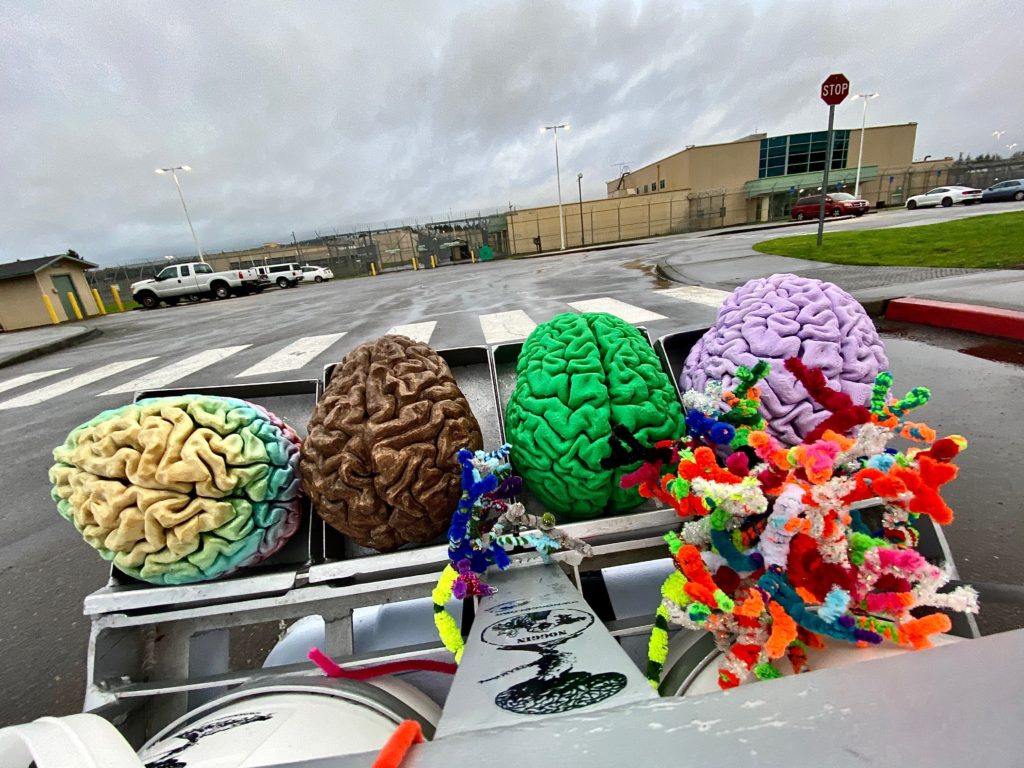
Metamorphosis
Coffee Creek, located in suburban Wilsonville, is a multi-custody prison accommodating all women inmates in the state of Oregon. Deb has about 20 students in “Metamorphosis,” her 15-credit, three-term PSU course based on the “Freshmen Inquiry” (“FRINQ”) model, where new students explore a theme from multiple perspectives throughout their entire first year.
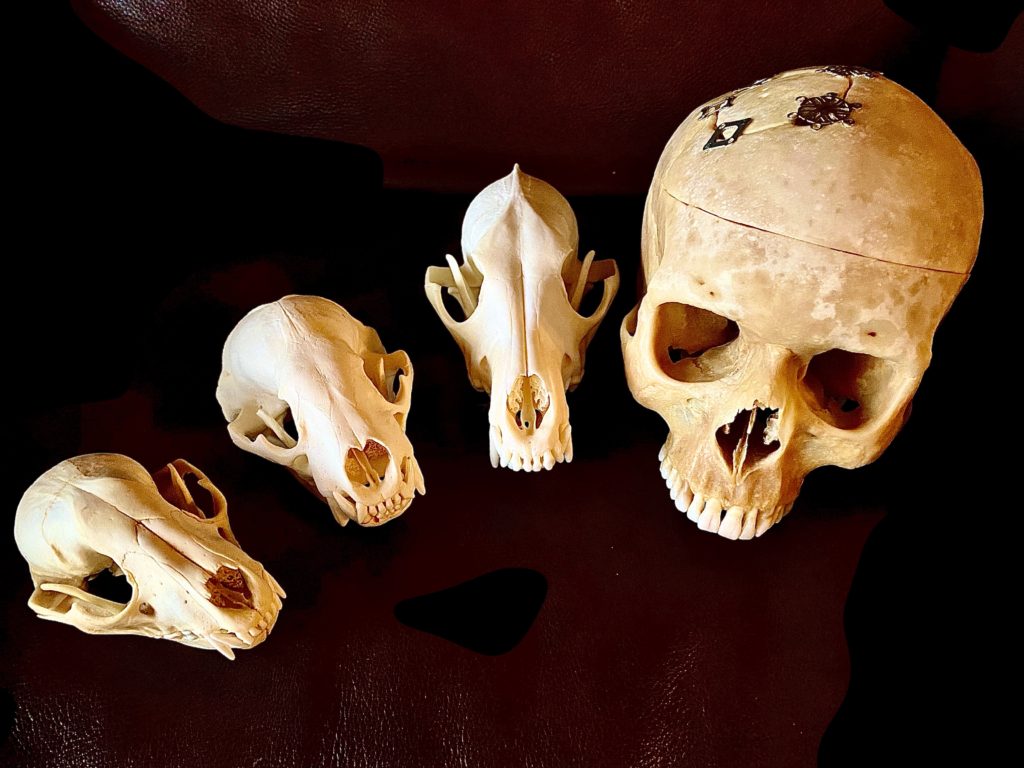
Metamorphosis, naturally, deals with change.
“How do we envision and experience transformation within ourselves, within our communities and within the world?”
― Deb Arthur, Portland State University
LEARN MORE: Portland State launches pathway toward a college degree for women serving time at Coffee Creek prison
Deb’s students are currently studying two examples of severely traumatic, imposed social disruption (the internment of Japanese U.S. citizens and the Trail of Tears), as well as two instances of “organic,” community-driven change (the modern civil rights movement and women’s suffrage).
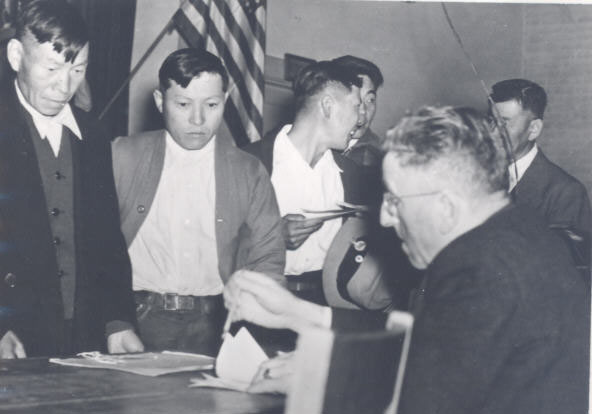
LEARN MORE: Japanese American Wartime Incarceration in Oregon
LEARN MORE: Trail of Tears
LEARN MORE: Teaching the Civil Rights Movement
LEARN MORE: The Woman Suffrage Movement
During the same week that Republican U.S. Senators voted to shield an impeached President from witnesses to his own criminal behavior, our NW Noggin volunteers arrived to consider bias, trauma, privilege, stress, resilience, development and mental health with those incarcerated at Coffee Creek.
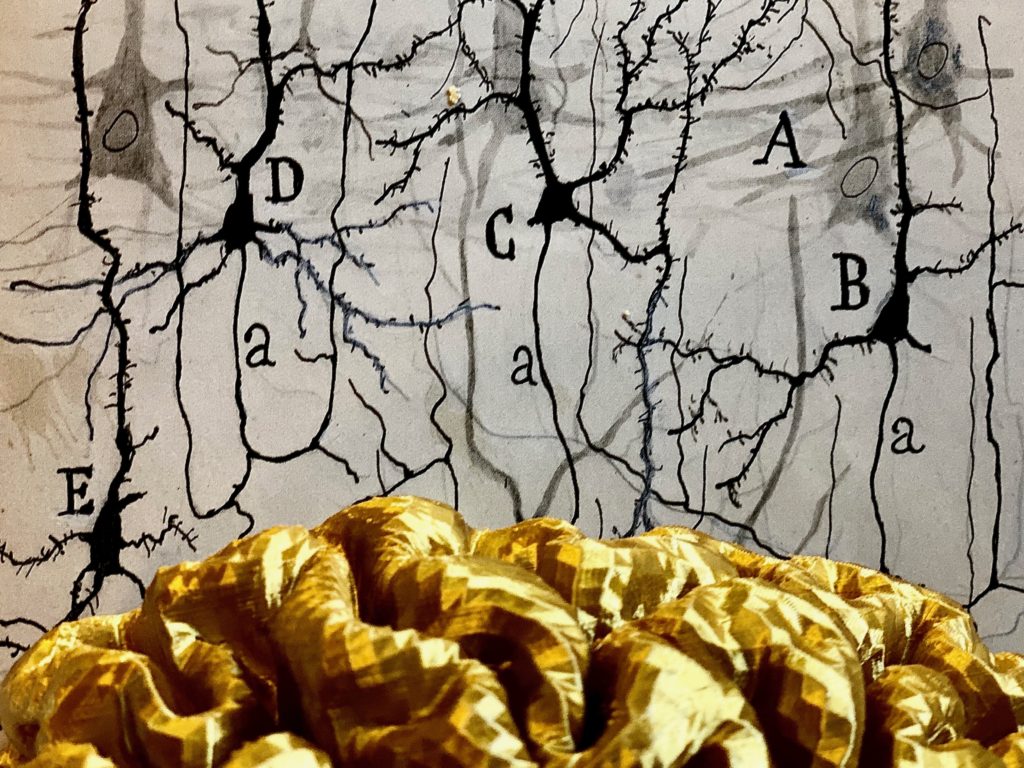
“The eager and often inconsiderate appeals of reformers and revolutionists are indispensable to counterbalance the inertia and fossilism marking so large a part of human institutions.”
― Walt Whitman
We’ve written extensively before about neuroscience research related to incarceration, including why bias and inequality can increase contact with law enforcement and judicial systems, and how different approaches to neighbors in challenging circumstances might help our communities improve.
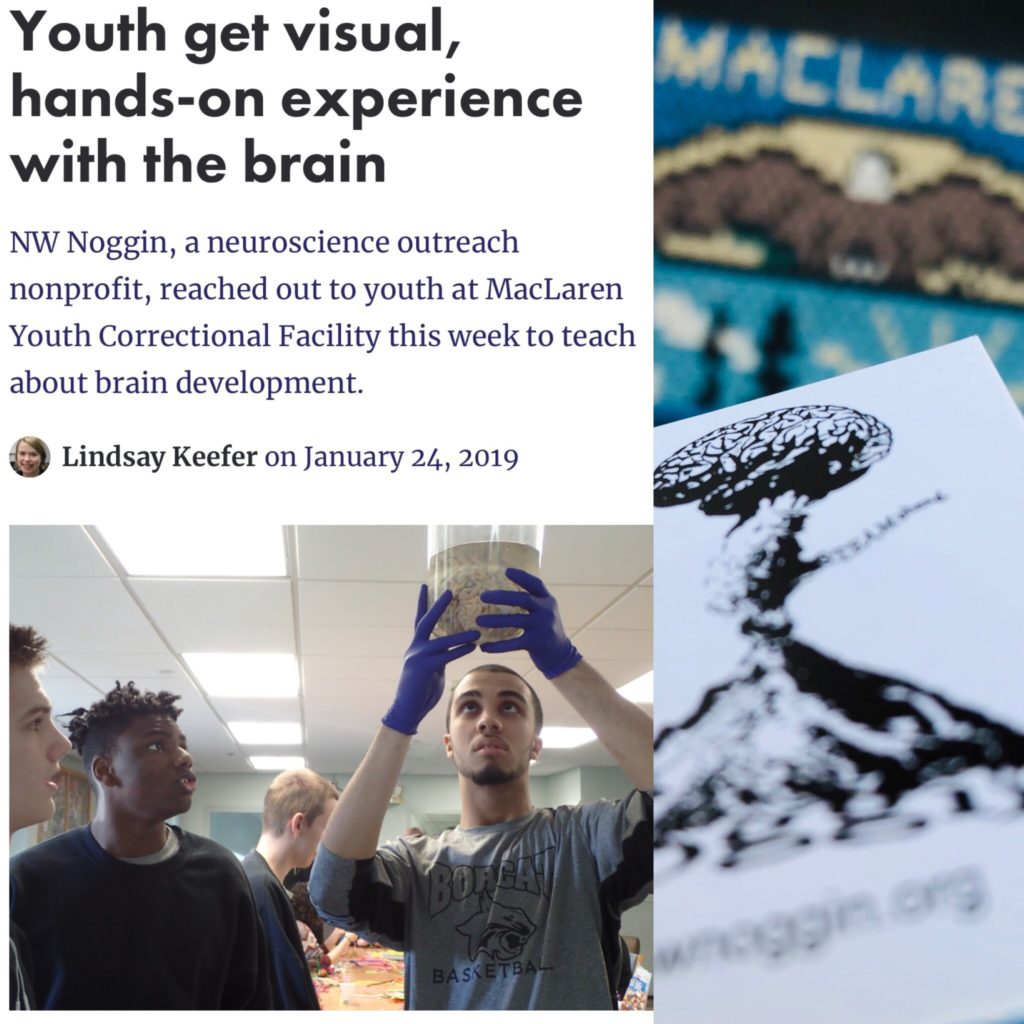
For example, thanks to the HOPE Partnership, our volunteers have visited the MacLaren Youth Correctional Facility on several occasions, listening to adolescents grappling with complex social environments and developing brains, who have tremendous capacity for further growth and change.
“Adolescence is characterized by heightened emotional reactivity, sensitivity to peer influence, impulsivity, and novelty seeking, with a seemingly limited capacity to engage self-control to override these emotions and actions.”
― Francis S. Lee et al
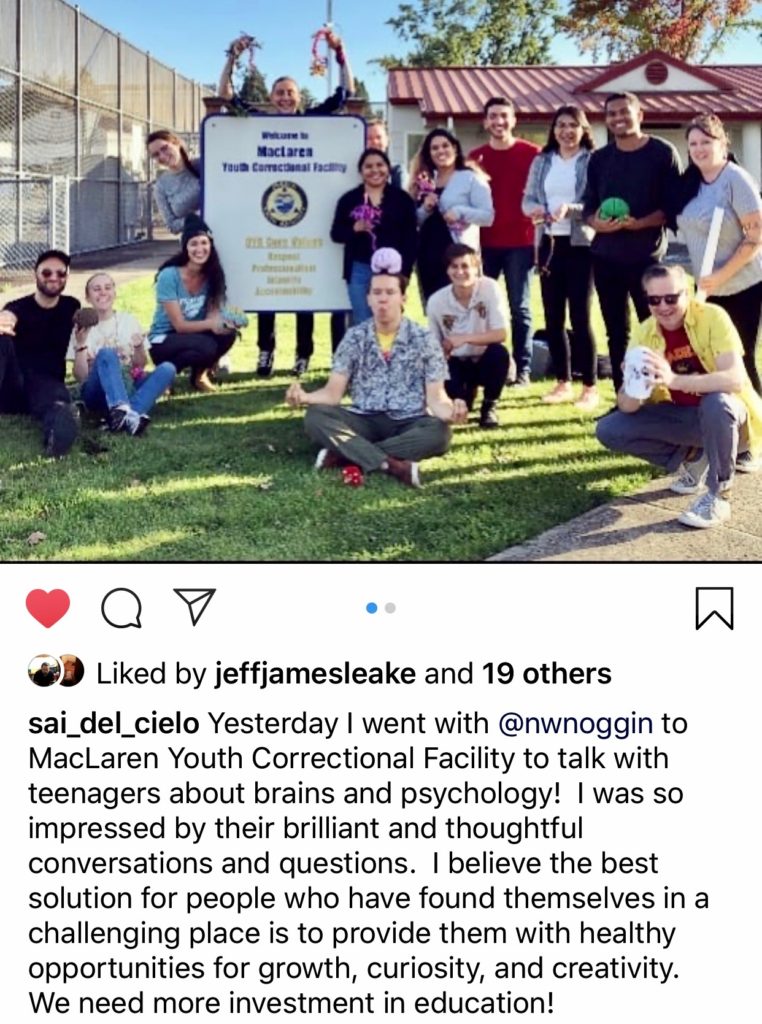
LEARN MORE: Myelinating at MacLaren
LEARN MORE: All is in motion, is growing, is you
LEARN MORE: Corrections, Bias & Brains

Challenges & Change
It was a wet and stormy Oregon morning, but we were greeted warmly by the officers at Coffee Creek Correctional Facility, and enjoyed some impromptu brain examination while storing our keys, phones and jackets before walking through an airport-style scanner to access the classroom.
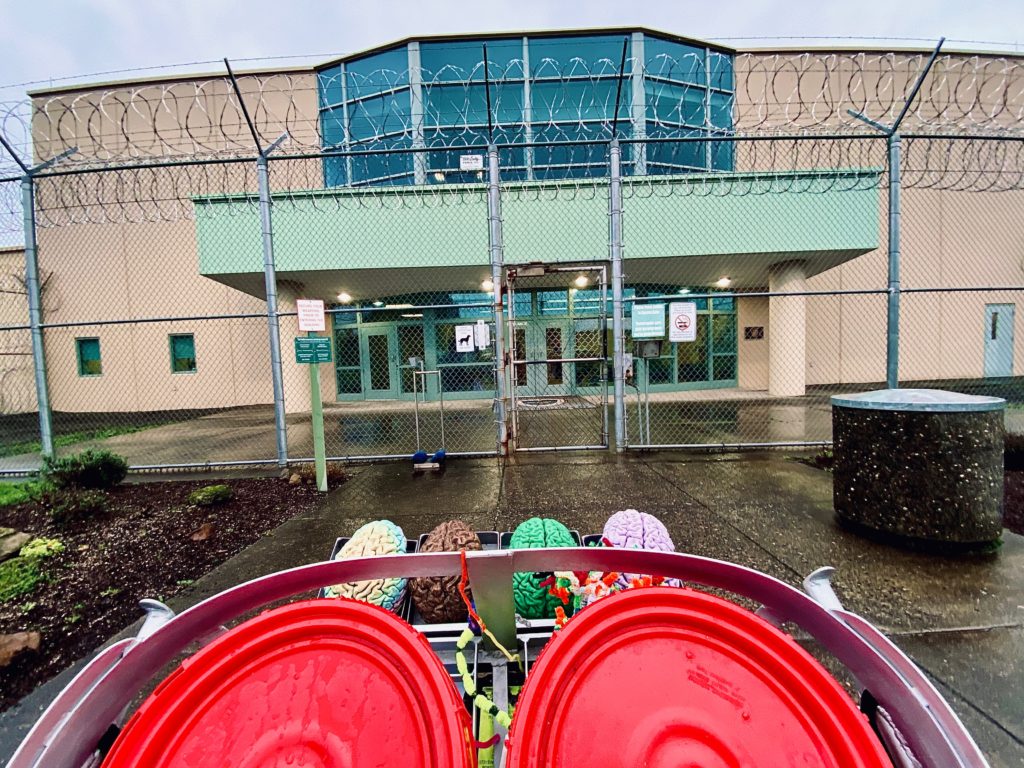
“I’d rather be this walking metamorphosis than having that old formed opinion about everything.”
― Raul Seixas
Jeff Leake and Bill Griesar (of NW Noggin) co-teach a different FRINQ course on the “(Neuro)science of Creativity and Learning” at Portland State, which involves plenty of community engagement. FRINQ student Aly Berry, and Sorrel Johnson and Annika Hokanson joined us from PSU, along with Jade Osilla from Lines for Life and graduate researchers Gail Stonebarger and Eileen Torres from Behavioral Neuroscience at OHSU.

We set out our noggins and skulls, pipe cleaners and pens, and nitrile gloves for brain wrangling as Deb’s students filed in. Lots of enthusiasm and curiosity in the room. And art!
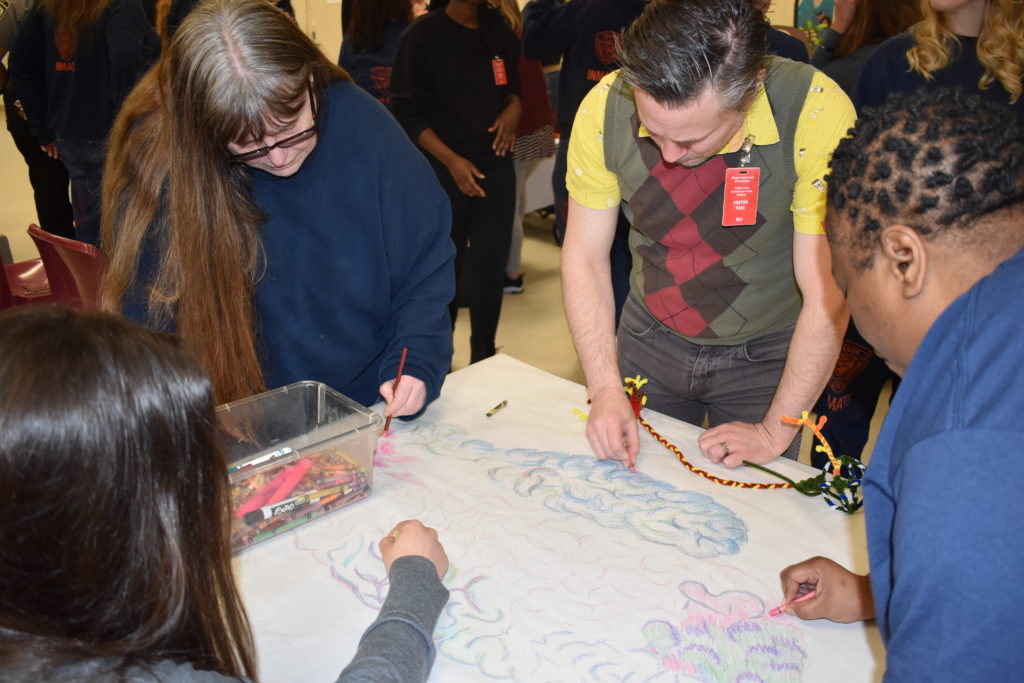
Deb began with great news, explaining that the Higher Education in Prison Program at PSU had just earned a substantial grant from The Sunshine Lady Foundation, whose mission “is to invest in organizations and programs dedicated to providing opportunities for the advancement of education, well being and new life choices for disadvantaged people…”
The Sunshine Lady Foundation’s name derives from the fact that “good luck does not shine equally on everyone.”

“We intend to use this (grant) to support classes and tuition to allow students at CCCF to continue on a pathway toward a degree.”
― Deb Arthur, Portland State University
Trauma, brains & genes
“I found it fascinating and I loved this information, it also triggered me – hearing about trauma and the brain.”
― Metamorphosis student at Coffee Creek
There were so many questions about trauma – both trauma experienced and trauma that some worried they might cause their own children because of their current situation.

“Shaping a new narrative about intergenerational violence and the impact across generations includes creating an understanding that environmental factors can and do affect families…breaking the intergenerational link of child maltreatment requires moving beyond parenting programs alone to incorporate the broader community and societal contexts that can help ensure the conditions for good health and well-being.”
― Melissa T. Merrick PhD and Angie S. Guinn MPH
LEARN MORE: Adverse childhood experiences and life opportunities: Shifting the narrative
LEARN MORE: Child Abuse and Neglect: Breaking the Intergenerational Link
We’ve written extensively before about how bias, stress and trauma, including trauma experienced by parents and grandparents, might impact chromosomes and ultimately alter the expression of our own genes. These epigenetic (“above the genome”) changes alter cellular structure (including brain structure), and thus how we (and our brains) might function, too.

LEARN MORE: Siletz Stories, Singing, Dancing & Brains!
LEARN MORE: Race, Bias & Brain: You Can’t Control Art
LEARN MORE: What Do You Mean, “Epigenetic”?
LEARN MORE: Epigenetics across the human lifespan
LEARN MORE: Topical Review: The Emerging Field of Epigenetics: Informing Models of Pediatric Trauma and Physical Health
LEARN MORE: The intergenerational effects of war on the health of children
LEARN MORE: Epigenetics and memory: causes, consequences and treatments for post-traumatic stress disorder and addiction
LEARN MORE: Epigenetic transmission of Holocaust trauma: can nightmares be inherited?
LEARN MORE: Paternal transmission of early life traumatization through epigenetics: Do fathers play a role?
One of our graduate volunteers from OHSU, Eileen Torres, has published research on the role of genes – specifically a set of alleles known as APOE2, APOE3 and APOE4 – in the relative probabilities of developing Alzheimer’s disease or PTSD.
From OHSU Behavioral Neuroscience graduate student Eileen Torres: “It is always rewarding to share my work with people that are not in research partly because it serves as practice to improve how I communicate. But more so than usual, my time at Coffee Creek reminded me why I invested in a research career. The questions I have, the questions I share with these women about why the brain works the way it does and how can we take better care of ourselves with this knowledge, are what excites me about neuroscience. I was so impressed by the depth as well as the expansiveness of the questions the women at Coffee Creek had for us. It was clear that each question had a personal motivation behind it. I certainly had to stay on my mental toes to keep up with everything!”
“We talked a lot about community and how important it is to our resiliency against stress and trauma. I loved learning more from a fellow volunteer, Jade Osilla from Lines for Life, about how her work helps organizations make better, trauma-informed decisions. It was really promising to hear how mental health is slowly being de-stigmatized.”
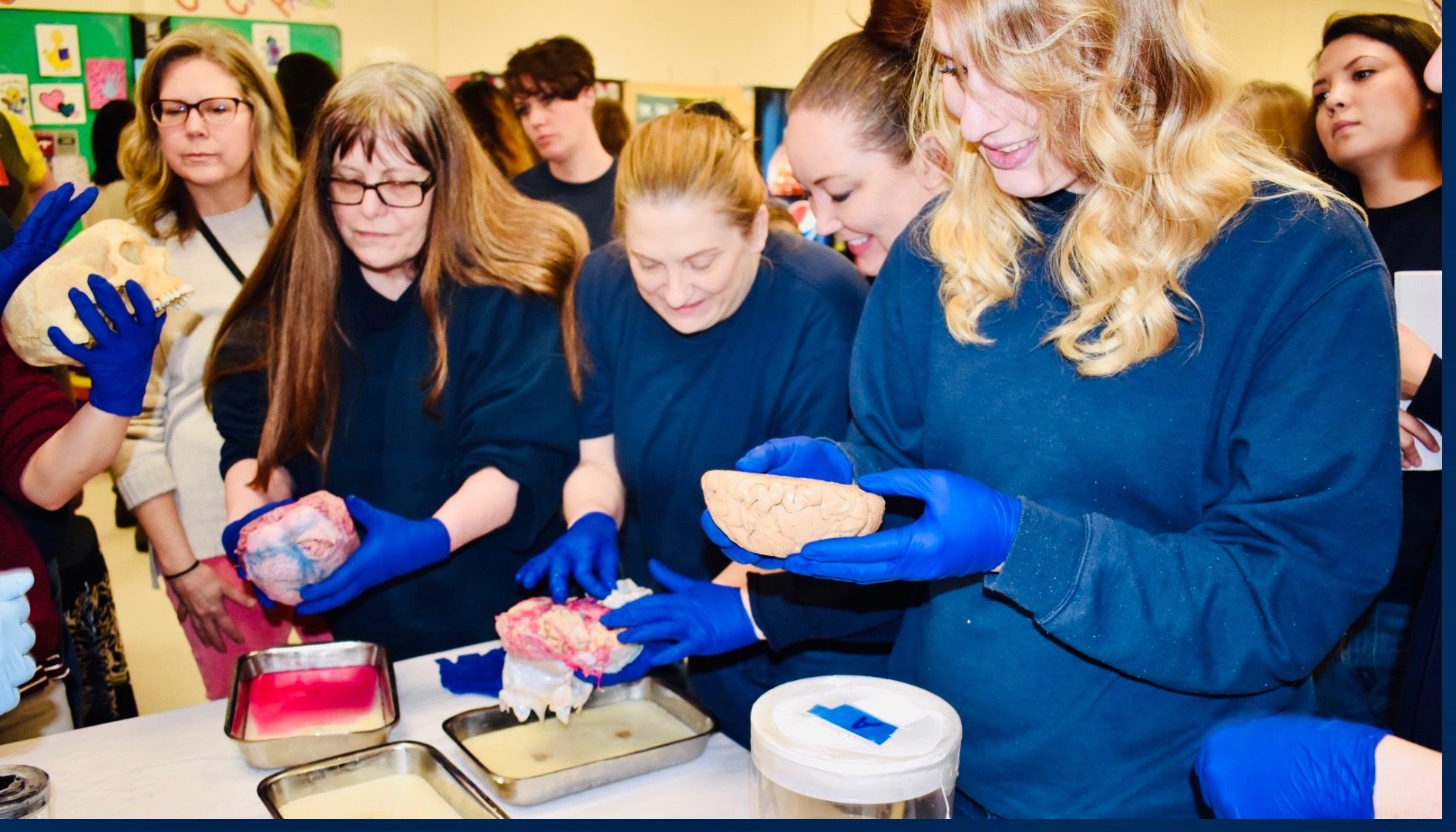
“If they want to learn more about PTSD and APOE, I’ve attached the paper that kicked off my project. For Alzheimers, I’ve attached a review. They’re dense papers, so anyone is welcome to send questions my way. Otherwise, here’s my super mini primer on APOE as it relates to AD and PTSD:
· Apolipoprotein E (APOE) is a gene that codes to create a protein, also called apoE. There are 3 main types of apoE: E2, E3, and E4. Each person carries 2 copies of this gene, so you can have copies that are the same, like E3/E3 (most common) or not, like E2/E4 (really rare!).
· ApoE transports cholesterol and other lipids around the body. The brain has ~25% of the body’s total cholesterol, so apoE is especially important in the brain. Cholesterol and other lipids are really important because they’re a big part of cell structure, can provide energy, and can act as signaling molecules.
· We have learned a LOT about apoE because E4 is the strongest genetic risk factor for developing late onset Alzheimer’s disease. But we still don’t know why it’s connected to Alzheimer’s disease (this is what I want to figure out!). E4 is also connected to cardiovascular disease and seems to interact with poor diet to result in worse cognitive problems.

LEARN MORE: APOE gene
LEARN MORE: ApoE4: an emerging therapeutic target for Alzheimer’s disease
· My own research centers on E2, which is relatively uncommon in the population. We have seen in mouse and human studies (along with other labs) that E2 corresponds with worse Post-Traumatic Stress Disorder (PTSD) symptoms and possibly greater risk of developing PTSD. The big question is what is happening in the brain that causes this. Some of my work suggests that oxysterols (breakdown products of cholesterol) may play a role in the stress response that is not working properly in E2 mice. I’m also working with the intercultural psychiatry program at OHSU to see if female refugees and people from Southeast Asia also show similar problems related to E2.
LEARN MORE: ApoE2 Exaggerates PTSD-Related Behavioral, Cognitive, and Neuroendocrine Alterations
Thank you Bill and Jeff at NW Noggin for organizing, Deb Arthur in University Studies for inviting us into her class, and all the people we interacted with at Coffee Creek!
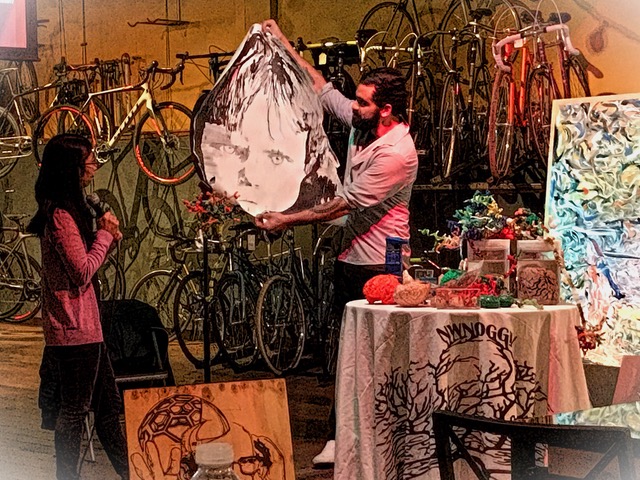
LEARN MORE: Feeling stressed?
“A disorder is not you”
From OHSU Behavioral Neuroscience graduate student Gail Stonebarger: “I was blown away by the knowledge base and curiosity these women showed up with; so many questions really made me reframe ways in which we think about certain psychological and physiological processes.”
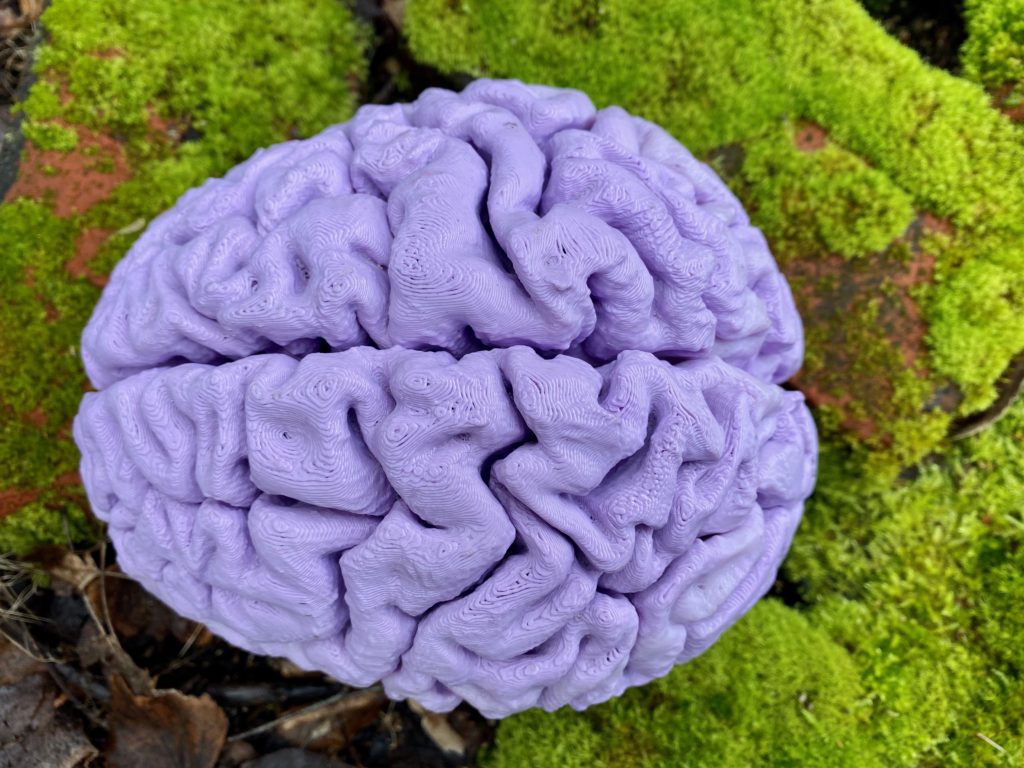
“The most powerful interaction I had was with a woman who told me she has been incarcerated for nearly two decades, and has struggled with drug addiction and intense treatment-resistant depression (TRD) since before her time at Coffee Creek. I am so impressed with the way she was able to shift her perspective with the help of mental health professionals at the facility. As she and I were talking, we discussed the concept of mental health stigma, and the difficulties in seeking help without fear of being told it’s for attention, or ‘faking it.'”
LEARN MORE: Changing Brain Waves of Depression
LEARN MORE: Treatment-resistant depression: recent developments and future directions
She told me that learning about biological mechanisms of depression helped her to feel a sense of relief, and a way to explain to both herself and those who care about her that suicidality and depression have a true biological basis, and aren’t just a failure on her part, or a cry for attention.
“I was so inspired by her positivity, and she explained to me that she feels empowered by showing her physical scars to others, in order to destigmatize depression and allow others who struggle to know they aren’t alone, and that it gets better. As someone who has also had significant difficulties with TRD, I felt really connected to her message and perspective.”
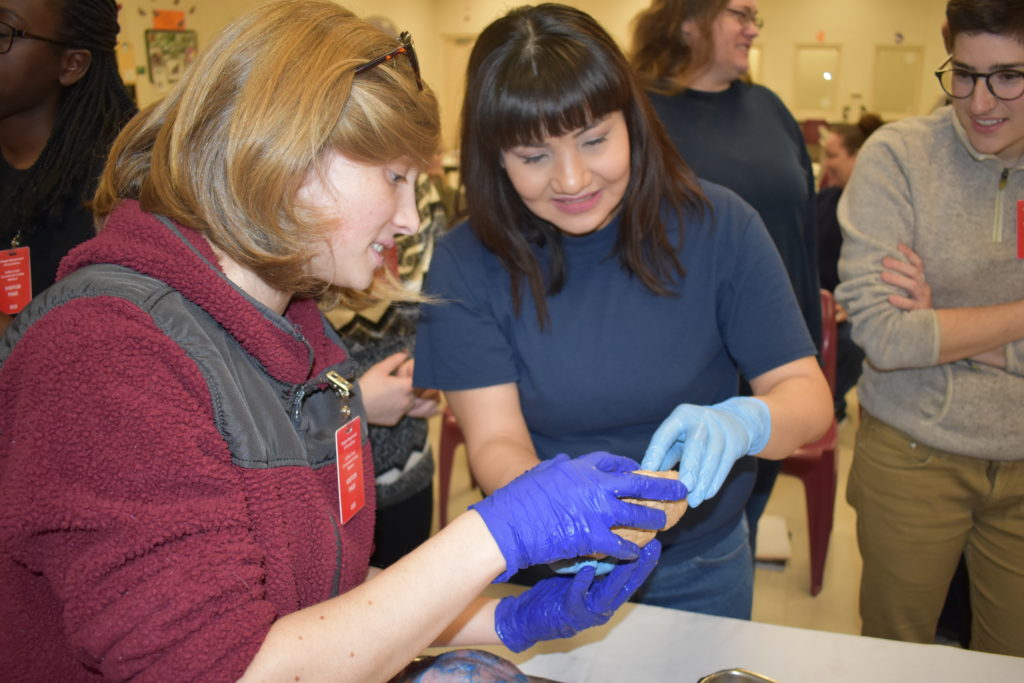
“The destigmatization of mental health disorders is a major impetus behind my decision to continue work in the neuroscience field. It’s empowering to know that a disorder is not you, and you are not the disorder; there is a biological, physiological basis, not unlike (although, generally much more disruptive than) a physical injury. The more people who can understand this, the more support and understanding becomes available to those of us who deal with invisible disabilities. This is wildly important, because we know that depression, especially suicidal depression, can have lasting impacts on not only the person experiencing it, but also those surrounding the person with depression, especially their children.”
“This recent study in HIV-positive mothers shows not only that children of mothers experiencing suicidal ideation are at higher risk for cognitive deficits, but, importantly, that the mother’s experience of depression coincided highly with being unmarried, experiencing moderate to severe hunger, and having elevated parental stress—all potential indicators of a lack of external support.”
LEARN MORE: Effects of Maternal Suicidal Ideation on Child Cognitive Development: A Longitudinal Analysis
“While it is disheartening that children of suicidal mothers seem to be predisposed to worse outcomes than their peers with ‘neurotypical’ parents, the positive message I glean from this study is that there are non-invasive interventions available in many cases: provide psychosocial support for parents who are struggling, and future generations are likely to have more beneficial outcomes.”
“In fact, authors from this research study find that a major mediating factor in suicidality is a sense of belongingness. To me, this highlights the importance of continued education surrounding mental health, but also the need to educate those who are not racial, gender, sexual, cognitive, emotional, or other minorities on ways to foster a sense of belonging between themselves and members of minority groups. My favorite part of this type of intervention is that anyone can take part! Simply being empathetic and kind towards those who seem different has the capacity to quite literally change the world for the better, and to potentially alleviate some of the generational trauma passed on to children of mothers with invisible disabilities.”
“Further highlighting the importance of belongingness and community, as well as the impact of insecurity and trauma, Australian authors published last year on findings which indicate that depression, suicidality, and PTSD rates in insecure refugees (asylum-seekers, temporary visas, and bridging visas, as opposed to legal permanent residency or citizenship) are significantly higher than in those with secure living situations. Further, depression symptoms were lower in refugees who had higher social engagement (participation in cultural, religious, athletic, political, student, volunteer, work-related, or other types of groups within the last 12 months). This same pattern holds true across aging—people who grow old and feel a sense of isolation are significantly more likely to be depressed, whereas social involvement predicts better mental health outcomes.”
“It’s very important to remember that depression, especially TRD and suicidal thoughts, cannot be ‘fixed’ simply by telling someone to be happy, or by being kind. However, creating an accepting support system—through which a person does not feel the isolation associated with depression as heavily—has the potential to save the lives of those struggling, as well as vastly improve the lives of their children and other loved ones. Transmission of trauma experiences can also be mediated through schema shifting; this very recent paper reveals that mothers who have undergone trauma and consequently form early maladaptive schemas (a schema being the way in which a person interacts with and understands the world around them, and the way in which we structure our thoughts and beliefs) are likely to pass this maladaptive perspective of the world on to their children. If these parents can identify these unhealthy patterns, and work with trained professionals to reframe their perspective of the world, these schemas are far less likely to be transmitted to their children. This is another reason why de-stigmatizing mental health is so important! Imagine how much pain could have been avoided if mental health was considered as ‘normal’ and important as physical health!”
LEARN MORE: Adverse childhood experiences lead to trans-generational transmission of early maladaptive schemas
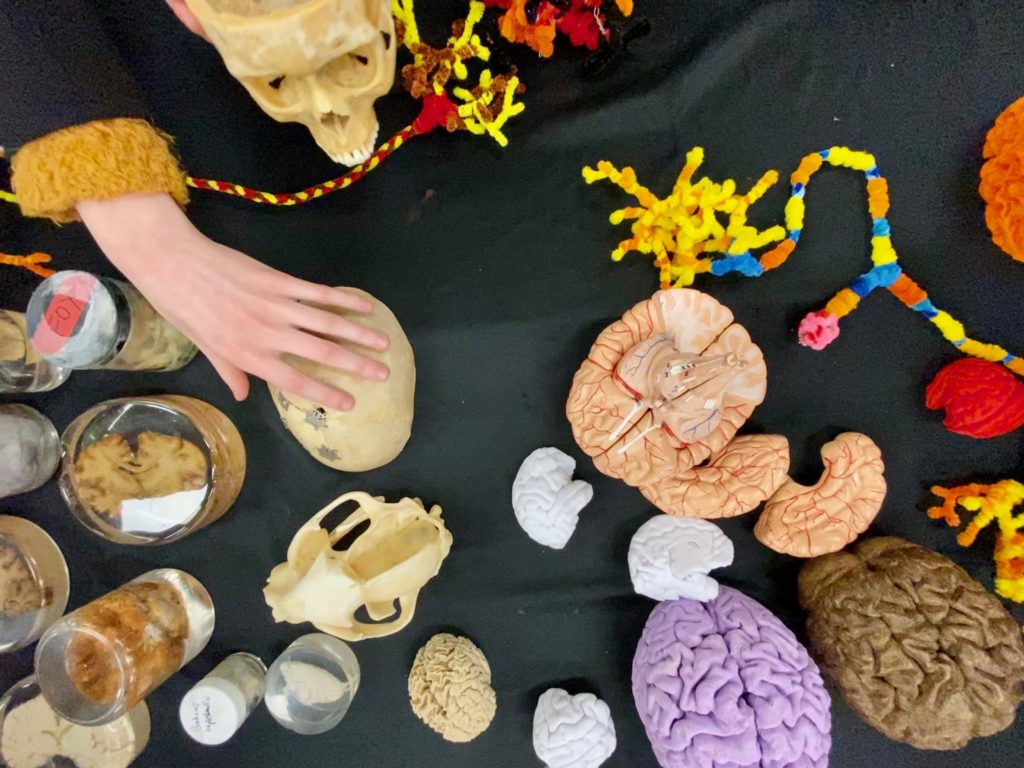
More reactions from those at Coffee Creek…
“It was gross in a way but really interesting”
“I dove in elbows deep; I would do this again and again and again”
“It was super cool, adding the art is such a good idea”
From PSU Psychology undergraduate Sorrel Johnson: “It was moving and surprisingly uplifting to visit Coffee Creek and meet with a group of people, typically separated from us by many locked doors, and to be reminded of what we have in common. Together, we exchanged knowledge and ideas; we considered questions about the relationship between the science and experience of being human, focusing on our remarkable capacity to change and be changed by those around us.”
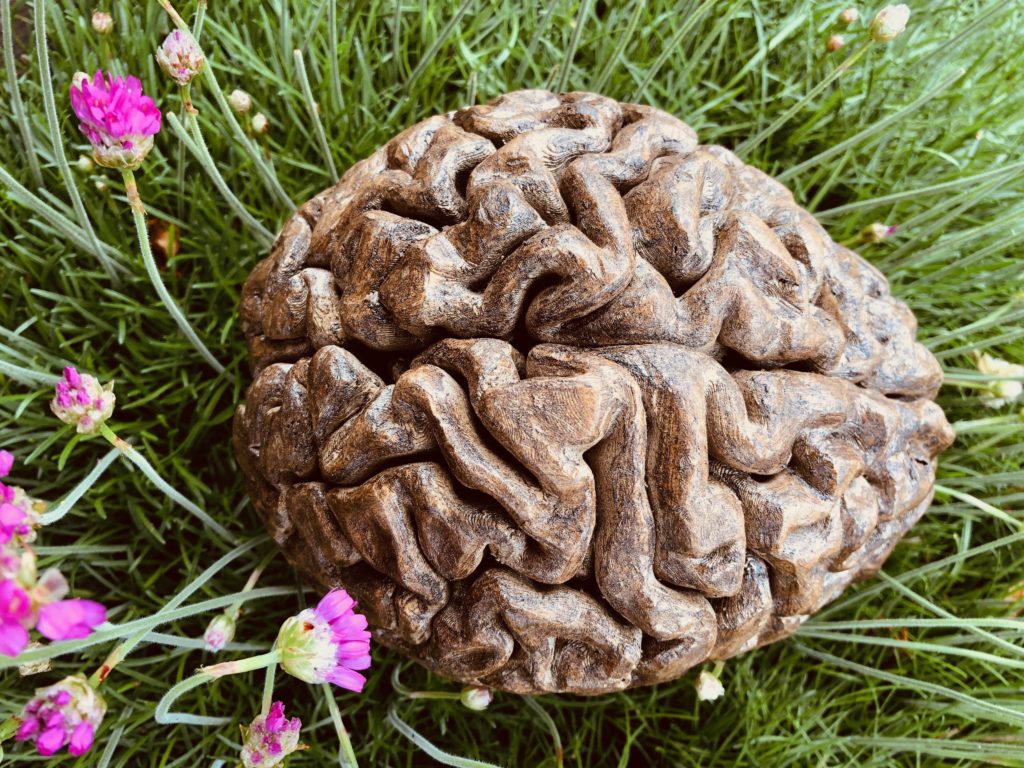
From PSU Psychology undergraduate Alyssa Berry: “As someone who is majoring in criminology and focusing on rehabilitative justice, I am a huge proponent for college classes in jails and prisons. Being able to be a part of the outreach to Coffee Creek Correctional Facility really solidified my belief in the value of engagement. I was also impressed by the number and depth of the questions that inmates asked us. I learned a lot! They really knew their stuff and it was encouraging to think that these classes and us coming in could actually be making a positive impact on us all.”
“Thank you so much to you all for coming in and sharing your expertise (and brains), and to DOC and CCCF for allowing this to happen!”
― Deb Arthur, Portland State University
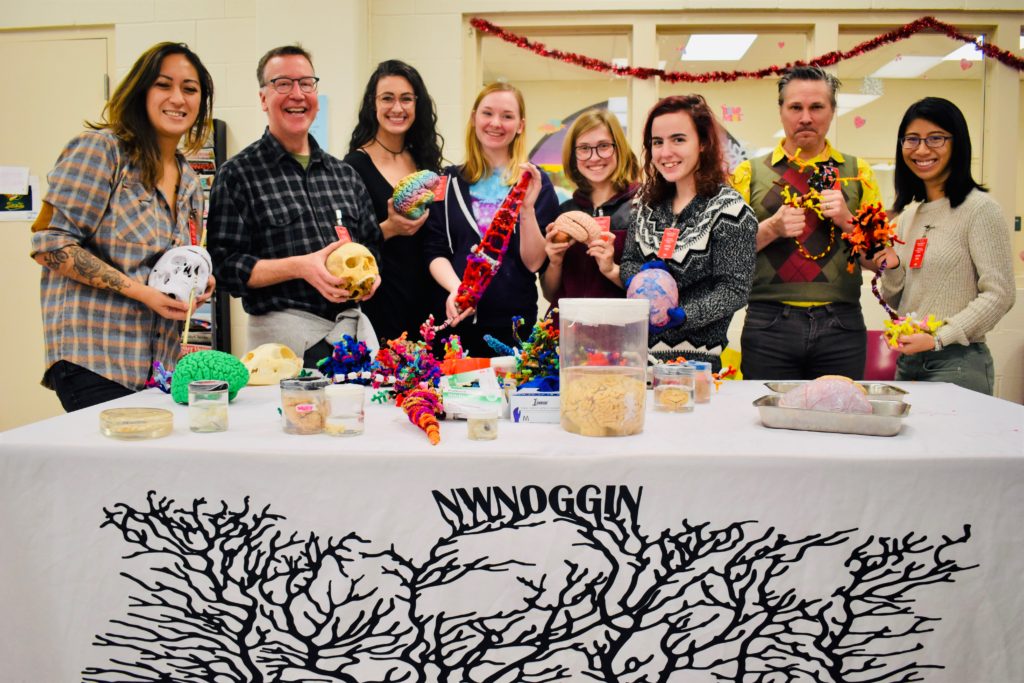
Our sincere thanks to Deb and her students and everyone at the Oregon Department of Corrections and Coffee Creek Correctional Facility for inviting us to visit!


